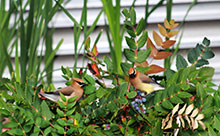
Your home’s yard, garden, or even balcony have the potential to provide essential habitat for plants and animals throughout the capital region. No matter what their size, natural spaces that you create near your home can increase biodiversity and support healthy ecosystems. Linked up with the bits of nature surrounding your home, like neighbouring yards, parks, boulevards, streams, and forests, your naturalized yard can create stepping stones or linkages that help plants and wildlife integrate into the urban landscape.
There are many benefits of gardening with biodiversity in mind:
- Conserve local biodiversity
- Create and maintain habitat and corridors for wildlife
- Attract wildlife that can help control potential pests in your yard
-
Pollination for food and beautiful flowers in our region
- Return nutrients to the soil through decomposition
- Support physical and mental health by caring for the environment, providing visual interest and safer spaces that attract wildlife to view
To help make your backyard a haven for local biodiversity, provide food, water and shelter for local species and use natural gardening techniques. For species specific information, check out our Attracting Wildlife PDF.
Food
Providing diverse, nutrient rich food sources in your yard is a key step to attracting native wildlife:
-
Garden with native plants that have co-evolved with local wildlife and provide great food for them.
- Plant many different types of plants to support a great diversity of wildlife. This helps make sure there is food available throughout the growing season. Pollinators and birds need flowers with different colours, shapes and bloom times.
-
Shrubs and trees with berries and seeds provide food for birds and small mammals.
- Rather than removing them, leave seed heads to dry on plants, providing an energy source for wildlife in the fall and winter.
Water
All animals need to drink water, and birds also depend on a water source for bathing. Depending on your budget and space there are different types of water sources you can add to your yard:
-
Bird bath: make sure to change the water and clean the container regularly to avoid the spread of disease and mosquitos.
- Insect dish: add pebbles or stones to a shallow dish with water. Change the water and clean the dish regularly.
-
Mud puddle: A wet, muddy area will be a favourite for birds and may also attract butterflies who consume nutrients in the soil.
-
Pond: make sure to have slope sides to allow many types of animals from birds to mammals and reptiles to safely get a drink.
Shelter
Use your yard to meet the diverse shelter needs of local species. Wildlife use shelter for rest, hunting, when seeking cover from the weather, for protection from predators, and when caring for young. Gardening with plants of various types and heights supports a greater diversity of wildlife:
- Many wildlife species prefer densely spaced gardens for cover from predators.
- Evergreen trees are particularly important in the winter months when temperatures are cooler whereas deciduous trees and shrubs can provide important shade mid-summer.
- Shrubs and trees provide perching and nesting sites for birds.
- Leave natural elements like snags (dead trees), brush piles, rocks and bare ground. As long as they are not a safety hazard, snags are vital for many local bird species as they use the tree cavity to sleep and raise their young.
- Brush or leaf piles provide cover as well as food if insects are living among them.
- Bare ground and tall grasses encourage nesting bees compared to manicured lawn and garden.
- If you do not have specific natural elements, artificial units like bird nesting boxes, bat houses and bug hotels can be alternatives.
Natural Gardening Techniques
-
Avoid pesticides. Pesticides damage non-target plants, pets, beneficial insects and wildlife. They pollute local waterways and the ocean, and contaminate soil and groundwater
Add compost.
- Add compost. It helps keep your soil loose, fertile, retain moisture and allows drainage.
- Use water wisely. Water in morning and evening when evaporation is lowest, and water at the base of plants where the roots will soak it up.
-
Garden with native plants.
- Remove invasive species from your yard and avoid planting them. Watch for invasive plants in wildflower mixes and labels that say “vigorous self-seeders” or “rapid spreaders.”
- Avoid buying plants that have been treated with neonicotinoid insecticides, which can harm pollinators. Ask your local greenhouse if you aren’t sure.
-
Mulch to conserve moisture, reduce weeds, add nutrients to soil as it decomposes, and provide shelter.
-
Green lawn care – reduce lawn area, grasscycle by leaving grass cuttings on the lawn and let your lawn go golden.
-
Learn more natural gardening practices here.